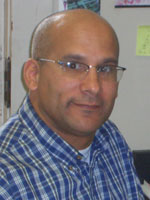
Nicholas J. Kenney
Hampton University
Journey of the Mammary Gland Apostles and Protégés
The year was 1971, and Bob Jenness of the University of Minnesota and Stuart Patton of Pennsylvania State University teamed up to organize the Biology of Milk Gordon Research Conference. Beginning in the 1960s, the work of such “apostles” as Kenneth DeOme, Satyabrata Nandi, Howard Bern, Yale Topper, and Sefton Wellings and their protégés emerged to lead the field of mammary gland biology and breast cancer research. The conference would host a combination of breast cancer biologists and mammary physiologists who wanted to expand the field beyond the focus on nutrition and cancer studies of most breast studies of the period.
The first Biology of Milk Conference was a success and a revolution for the field. Several of the apostles of mammary gland biology were present. Of special interest was the identification of the milk protein alpha-lactalbumin as the B protein component of the lactose synthetase enzyme complex in the mammary gland (i.e., alpha-lact-albumin is a major protein of breast milk and is required for lactose synthesis). The conference continued to meet every two years and in 1977 was renamed Mammary Gland Biology (MGB). Throughout the 1970s the MGB Conference featured fascinating aspects of lactation biology, oncogenic activity, and in vitro three-dimensional growth systems. Pioneering these observations were the apostles, their protégés, and an international contingency from Holland.
The next decade saw the arrival of the transgenic mouse. Later in the decade Philip Leder led this area and gave an entertaining talk at the MGB Conference about MMTV-
ras and
myc transgenic mammary glands. About the same time Lothar Hennighausen and his collaborators talked about transgenic pigs that expressed human clotting proteins in the mammary gland and secreted them into milk. A new genre arose out of these presentations referred to as “signaling transduction in the mammary gland.” Signaling concepts in the mammary gland would later propel mammary biologists into today’s field of the molecular aspects of mammary gland development and cancer.
As a young, impressionable graduate fellow at the National Cancer Institute (NCI) in Bethesda, Maryland, I had just begun to hear the terms
fat pad and
outgrowths and learn about slow-release pellets and tissue-specific promoters that target the breast. Under the guidance of the second-generation mammary biologist David Salomon, I was exposed to historical perspectives on mammary gland biology and to its pioneers, all of whom attended the MGB Gordon Conference religiously. After hearing about the apostles and working alongside two of them–namely, Barbara Vonderhaar and Gilberth H. Smith–I was looking forward to my first MGB Conference.
I had previously attended several meetings about cancer but for the most part felt out of place, bored, and somewhat demoralized–probably because there were few young urban minorities like myself in attendance. My first experiences at GRC were totally different: I had a chance to meet, converse, jog, and play basketball with some of the mammary gland biology apostles. Today the environment of the MGB Gordon Conference environment still allows for the free exchange of ideas, information, and techniques; most important, it is free from barriers like egotism and elitism.
I remember how in the early 1990s Charles Daniel brilliantly explained the nuances of mammary ductal elongation, branching, terminal end bud formation and components, and stem-cell contributions to the mammary duct. Daniel’s nomenclature, histology, and biological knowledge date back some forty years and form the foundation that most mammary gland biologists and breast cancer researchers use today. Other recent topics include Daniel Medina’s oft-used cell culture—derived hyperplastic immortalized cell lines and their cytogenetic characteristics and Robert Cardiff’s tutorial on the pathological aberrations or “new definitions” of breast cancer morphology. I should add that I will never forget Cardiff’s mastery on the basketball court, or how, twice in ten years, he swept me in four consecutive games of twenty-one, even if he did cheat in one of them.
The MGB Conference gave me a chance to sit down and discuss retroviral fat-pad injections with Daniel and Smith, which led to fruitful collaborations. I also had the opportunity to give my first mini-symposium on the location of stem cells in the mouse mammary gland. I remember an E. F. Hutton—like moment while sitting at the lunch table with Robert Clarke, Elizabeth Anderson, Nicholas Zeps, Jeff Rosen, Jeff Green, and a few other covert ears nearby: they all asked, “How did you do it–double-label stem cells in vivo?” Using the data and discussions from this talk, most, if not all, mammary gland biologists attempting to label and transplant stem cells in vivo have used my techniques (5-bromo-2-deoxyuridine [BrdU]–a chemical base analog of thymidine used to detect the proliferation of living cells–and fluorescent cell tracers) since 1999.
Since first attending the MGB Conference, I have also witnessed a number of extremely talented women present research work ahead of its time, and I greatly respect their proactive quests to follow in the footsteps of Pitelka and lead us to the cure for breast cancer.
The conference still holds to its original mission–to provide a forum for the exchange of new knowledge, while being pleasant and entertaining. Much like a coach’s relationship to an athlete, the MGB Conference has guided the direction of ongoing breast cancer research. As a history buff I have always found the MGB Conference refreshing and somewhat humbling in that some of the lecturers are finally seeing the fruits of their long journey. What a wonderful treat the MGB Gordon Conference has been.